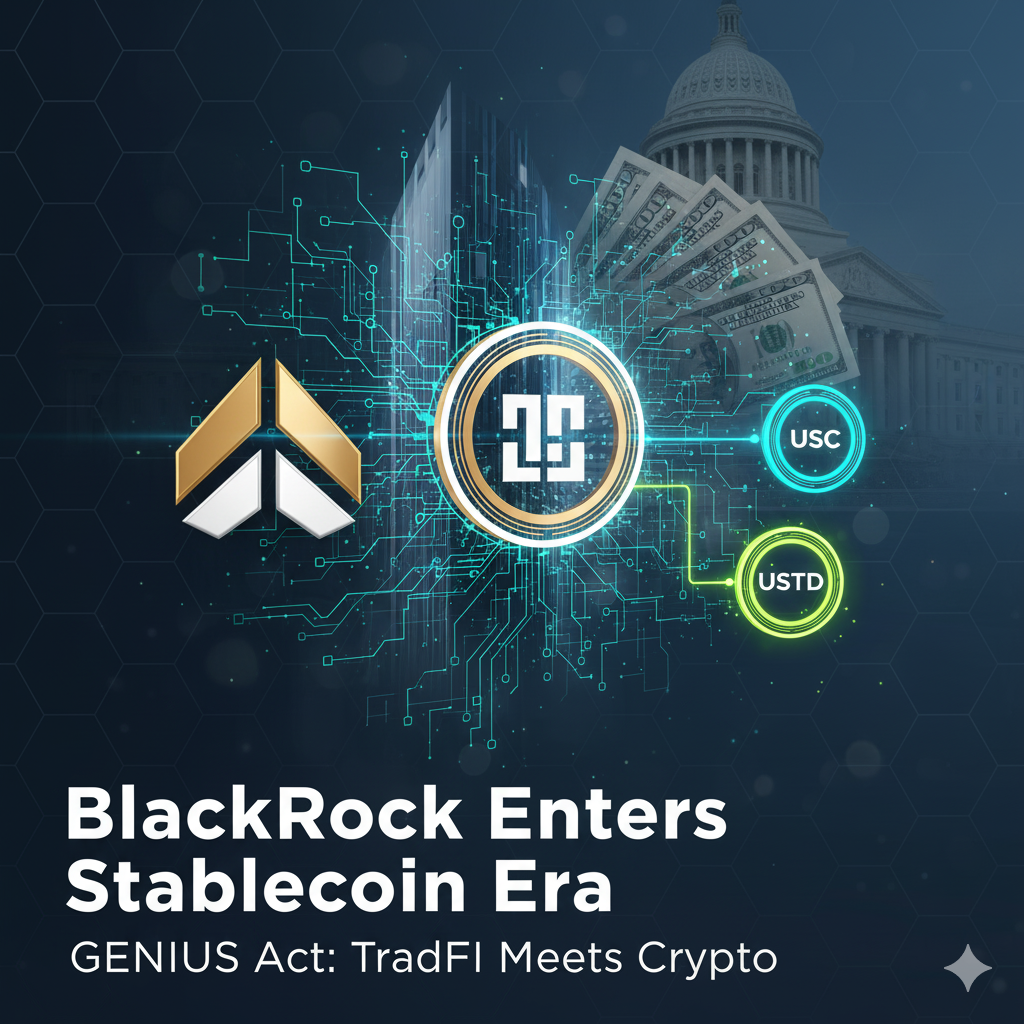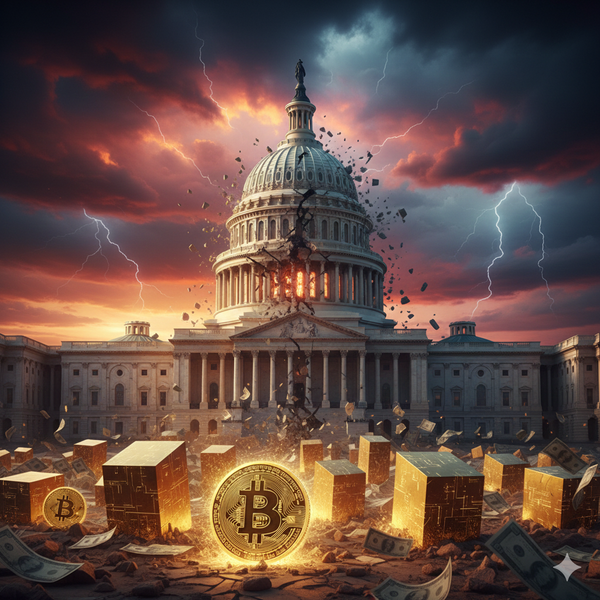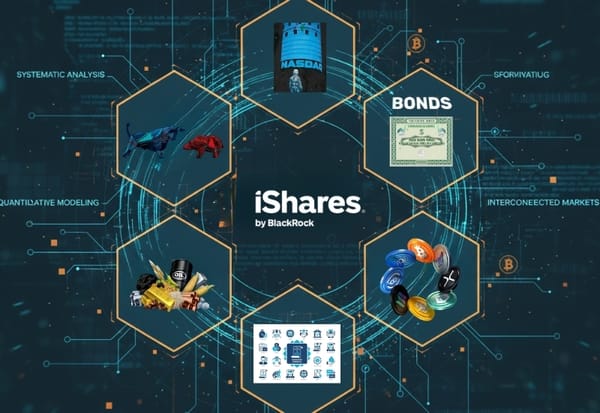BlackRock Launches GENIUS-Compliant Fund for Stablecoin Reserves
BlackRock launches GENIUS-compliant money market fund for stablecoin reserves, positioning the $13.5T asset manager as premier infrastructure provider for digital currencies. The move validates crypto's institutional future as the $313B stablecoin market eyes $2T+ growth by 2028.

In a watershed moment for crypto and traditional finance convergence, BlackRock, the world's largest asset manager with $13.5 trillion under management, has restructured its money market fund to serve stablecoin issuers under the newly enacted GENIUS Act. This strategic pivot positions the financial giant as a premier reserve manager for regulated dollar-pegged digital currencies.
The New Reserve Infrastructure
BlackRock announced on Thursday that its BlackRock Select Treasury Based Liquidity Fund (BSTBL) has been retooled specifically to meet the reserve management needs of stablecoin issuers. The fund now invests exclusively in short-term U.S. Treasury securities and overnight repurchase agreements, providing the ultra-safe, highly liquid vehicle that the GENIUS Act mandates.
"We're seeing increasing demand from stablecoin issuers and clients seeking innovative, compliant reserve management solutions," said Jon Steel, Global Head of Product and Platform within BlackRock's Cash Management business. "We want to be—and we believe we are—a preeminent reserve manager for stablecoin issuers."
The fund features extended trading hours until 5:00 PM Eastern Time and later valuation times to accommodate the 24/7 nature of crypto markets. With a management fee of 0.21% and total expenses of 0.27% after waivers, BSTBL offers institutional-grade reserve management at competitive rates.
Understanding the GENIUS Act Framework
The Guiding and Establishing National Innovation for U.S. Stablecoins Act, signed into law by President Donald Trump in July 2025, establishes the first comprehensive federal regulatory framework for stablecoins in the United States. The legislation requires:
- 1:1 Reserve Backing: Stablecoin issuers must maintain full backing with U.S. dollars, Treasury bills, or similar liquid assets
- Monthly Audits: Regular third-party attestations of reserve compositions
- Federal and State Oversight: Licensing requirements through the Treasury Department and Office of the Comptroller of the Currency
- Anti-Money Laundering Compliance: Robust KYC (know-your-customer) and AML standards
- Prohibition on Yield Distribution: Issuers cannot offer interest to holders, favoring tokenized money market funds
This regulatory clarity has been eagerly anticipated by the $313 billion stablecoin market, which has long operated in a gray zone between innovation and compliance.
Market Implications and Growth Projections
The timing of BlackRock's move aligns with explosive growth projections for the stablecoin sector. Current market estimates show stablecoin issuers already holding over $200 billion in U.S. Treasuries—making them one of the largest holders of U.S. government debt globally, surpassing countries like Germany.
Industry forecasts vary but paint a consistent picture of dramatic expansion:
- JPMorgan: $500 billion by 2028
- Standard Chartered: $2 trillion by 2028
- Citi (base case): $1.9 trillion by 2030
- Bernstein: $4 trillion by 2035
TD Cowen analysts predict that the onchain capital base could exceed $100 trillion within five years as tokenization spreads across asset classes. This backdrop supports why cash-management products aimed at stablecoin issuers are attracting significant institutional attention.
BlackRock already manages reserves for Circle, the issuer of USDC, through a long-standing partnership. The BSTBL fund aims to extend this model to additional issuers as demand for regulated, yield-bearing reserve options accelerates.
Regulatory Landscape: Reducing SEC Influence
A crucial aspect of the GENIUS Act is its jurisdictional impact. By assigning oversight to the Treasury Department and OCC rather than the Securities and Exchange Commission, the legislation provides clearer pathways for stablecoin operations outside the SEC's historically aggressive regulatory approach to crypto assets.
This shift creates a more favorable environment for institutional adoption, as companies can now navigate a defined compliance framework rather than facing enforcement actions based on evolving interpretations of decades-old securities laws.
In July, Anchorage Digital Bank announced a partnership with Ethena Labs to package the DeFi startup's USDtb token as the first U.S. GENIUS-compliant stablecoin, demonstrating how quickly the market is moving to capitalize on the new regulatory structure.
XRP and Ripple: Strategic Positioning in the New Era
The GENIUS Act creates significant opportunities and nuances for Ripple and its native token XRP, though the impacts are more complex than simple price appreciation narratives suggest.
RLUSD: Ripple's Compliant Stablecoin
Ripple's dollar-backed stablecoin, RLUSD, is positioned to benefit substantially from the GENIUS framework. As Yuri Brisov, Partner at Digital & Analogue Partners, told Decrypt: "The existence of RLUSD would allow Ripple to become a native, on-shore liquidity provider in the U.S., competing directly with USDC and PayPal USD. This will allow Ripple to reconfigure itself as a core infrastructure provider within the U.S. financial system."
RLUSD operates on multiple networks, including the XRP Ledger, and already meets GENIUS Act requirements with transparent reserve holdings and monthly attestations from third-party accounting firms. BlackRock's new fund could serve as a reserve management solution for RLUSD, strengthening Ripple's institutional credibility.
XRP's Utility, Not Price Impact
However, analysts caution against expecting direct XRP price surges from stablecoin regulations. While every RLUSD transaction on the XRP Ledger burns a small amount of XRP to cover network fees, this volume is negligible compared to XRP's 59.1 billion circulating supply. The XRP Ledger has cumulatively burned only 14 million tokens since inception.
Ripple CTO David Schwartz has tempered expectations, stating: "I still don't think burned XRP will significantly reduce the supply any time soon."
Regulatory Clarity Remains Incomplete
XRP's classification remains legally ambiguous. While XRP is not deemed a security when sold programmatically on exchanges, it "may constitute a security in institutional placements," according to Brisov. This split designation means regulatory uncertainty persists.
The GENIUS Act allows Ripple to strategically "reduce reliance on XRP" in contexts where regulatory uncertainty persists by leveraging RLUSD instead. If the proposed CLARITY Act—which would establish a formal path for digital assets to transition from securities to commodities—passes, XRP could gain much-needed legal clarity.
Institutional Adoption and Cross-Border Utility
The real opportunity for XRP lies in its role as a bridge asset for cross-border liquidity. As stablecoin regulations solidify, banks still rely on pre-funded Nostro/Vostro accounts at correspondent banks to settle international payments. XRP's on-demand liquidity model bypasses these hurdles by sourcing liquidity only when transactions occur—moving value directly between parties in seconds with minimal counterparty risk.
Ripple's network includes diverse global banking partners: Santander and CIBC in North America, Itaú Unibanco and BeeTech in South America, Kotak Mahindra Bank and IndusInd in India, InstaReM in Singapore, LianLian in China, SBI Remit in Japan, RAKBANK in the UAE, and Sweden's SEB and the U.K.'s IFX among others.
Austin King, co-founder of Omni Network, notes: "Ripple is uniquely positioned to benefit from this new legislation. The law gives stablecoins like USDC and RLUSD a competitive advantage when it comes to institutional adoption, which is where the real winners will be made."
Long-Term Outlook
For XRP holders, the GENIUS Act represents a step toward regulatory maturity rather than an immediate catalyst. The legislation strengthens Ripple's business operations through RLUSD, potentially increases institutional confidence in compliant crypto infrastructure, and validates the utility token thesis—but it doesn't resolve XRP's security status or guarantee price appreciation.
The trajectory signals a broader market evolution away from speculative hype toward real-world utility. As regulatory clarity improves and Ripple expands its network, XRP could play a central role in reshaping global financial infrastructure—but that transformation will unfold over years, not weeks.
Competitive Landscape and Partnership Opportunities
BlackRock's entry intensifies competition for stablecoin reserve management. The firm brings unparalleled institutional credibility, having already established itself as a leader in digital assets through:
- Bitcoin and Ether ETFs: The largest exchange-traded products for both cryptocurrencies
- BUIDL Token: The world's largest tokenized private fund—a short-term U.S. Treasury strategy operating on Ethereum with 24/7 functionality
- Circle Partnership: Existing reserve management for USDC, the second-largest stablecoin with approximately $67 billion market cap
CEO Larry Fink has repeatedly stated that he views tokenization as one of the most exciting opportunities in finance, predicting it will connect traditional finance with the expanding digital asset market. With over $4.5 trillion already in digital wallets, Fink expects rapid growth in coming years.
Risks and Considerations
While BlackRock's BSTBL fund offers institutional-grade solutions, investors should understand the inherent risks:
- Not FDIC Insured: The fund is not a bank account and carries no federal insurance or guarantees
- Loss Potential: Although the fund seeks to preserve $1.00 per share value, it cannot guarantee this outcome
- Market Stress: BlackRock is not required to reimburse the fund for losses, even during market turmoil
- Regulatory Evolution: Stablecoin regulations continue to develop; future rule changes could impact operations
- Systemic Risk: The concentration of significant Treasury holdings within a handful of crypto-native firms introduces potential systemic vulnerabilities, particularly the risk of mass redemption events triggering Treasury market volatility
Federal Reserve analysis also suggests that stablecoin growth necessarily diverts funding from other uses, such as bank loans to the economy, potentially reducing credit availability.
The Bigger Picture: Traditional Finance Meets Crypto
BlackRock's BSTBL launch represents more than a new financial product—it symbolizes the institutional validation of crypto infrastructure. As one crypto commentator noted: "BlackRock is building the backbone for regulated stablecoins. This isn't experimentation; it's infrastructure. Traditional finance is merging with crypto, piece by piece."
The move arrives as banks and asset managers increasingly pilot tokenized money-market exposures for collateral and 24/7 liquidity. Many on Wall Street now view tokenization as a durable modernization of market plumbing rather than speculative innovation.
For the crypto industry, GENIUS Act compliance and institutional-grade reserve management eliminate major adoption barriers. Regulated stablecoins can now integrate into payment systems, corporate treasury strategies, and cross-border settlement networks with legal certainty.
For traditional finance, the stablecoin ecosystem represents a new distribution channel and revenue opportunity. As stablecoin issuers capture yield from Treasury holdings—Tether reported $13.7 billion in profits for 2024 alone—asset managers like BlackRock can provide the compliant infrastructure that powers this growth.
Conclusion: A New Chapter for Digital Finance
BlackRock's GENIUS-compliant money market fund marks a pivotal convergence point between the world's largest asset manager and the rapidly maturing stablecoin industry. By offering institutional-grade reserve management solutions, BlackRock is positioning itself as essential infrastructure for the next phase of digital currency adoption.
Key Takeaways:
- Regulatory Clarity Has Arrived: The GENIUS Act provides the comprehensive federal framework that stablecoin issuers have sought for years, enabling compliant operations at scale
- Institutional Capital Is Entering: BlackRock's $13.5 trillion in assets under management brings unprecedented credibility and resources to crypto infrastructure
- Market Growth Is Accelerating: Projections of $2-4 trillion in stablecoins by 2028-2030 underscore the sector's explosive potential
- XRP/Ripple Face Nuanced Impacts: While RLUSD benefits from regulatory clarity, XRP's direct price impact remains limited; long-term value depends on adoption as a bridge asset and resolution of security classification
- Traditional Finance Is Transforming: Tokenization is no longer experimental—it's becoming core financial infrastructure
For investors, institutions, and crypto enthusiasts, BlackRock's move signals that digital assets are entering the mainstream of capital markets. The question is no longer whether traditional finance and crypto will converge, but how quickly—and who will lead the transformation.
DISCLAIMER: This newsletter is for informational purposes only and does not constitute investment advice, advertising, or a recommendation to buy, sell, or hold any securities. This content is not sponsored by or affiliated with any of the mentioned entities. Investments in cryptocurrencies or other financial assets carry significant risks, including the potential for total loss, extreme volatility, and regulatory uncertainty. Past performance is not indicative of future results. Always consult a qualified financial professional and conduct thorough research before making any investment decisions.
Sources
- BlackRock Official Press Release - BusinessWire
- The Block - BlackRock GENIUS-Compliant Fund Launch
- Cointelegraph - BlackRock Stablecoin Reserve Fund
- CNBC - GENIUS Act and Crypto Week
- Decrypt - What the GENIUS Act Means for XRP Investors
- The Crypto Basic - GENIUS Act XRP Impact Analysis
- BeInCrypto - GENIUS Act XRP Price Impact
- The Coin Republic - GENIUS Act and XRP Bridge Asset Role
- The Global Treasurer - Stablecoin Market Treasury Holdings
- Federal Reserve Bank of Kansas City - Stablecoin Treasury Demand Analysis
- Visual Capitalist - Stablecoin Market Size Forecast
- ARK Invest - Stablecoins as US Financial Ally
- Coinpedia - BlackRock Money Market Fund for Stablecoin Issuers
- American Bazaar Online - XRP and GENIUS Act Analysis



